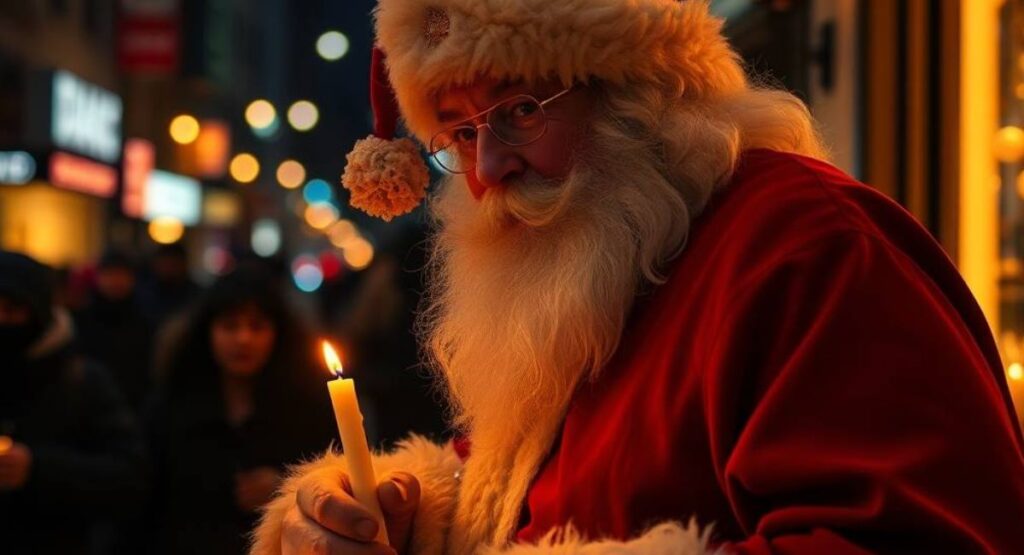
Santa Claus is a fat, jolly old man dressed in red who brings presents to good little children on Christmas Eve. Generosity, good cheer, and bliss are his qualities. However, dark history of santa claus behind his cheerful visage is an equally perplexing, strange, and sometimes frightening tale. For beyond mere history, it begins with the legends of yore dotting the dark Santa Claus stories, which have somewhat cloaked society for ages, intermingling folklore with pagan traditions and some religious influences, infused even with some stories which were meant to frighten children into good behavior.
This article will dig into the dark origins of Santa Claus. From ancient Norse gods to medieval punishment, throw holiday helpers and a truckload of eerie twists, his past is a frightful wonderland. Discovering these origins will help us not only appreciate the holiday traditions we adopt today but also witness how myths formulate and adapt to cultural needs throughout history.
The Pagan Roots Behind the Dark History of Santa Claus
Long before Santa Claus was known as a magical gift-bringer, European societies celebrated winter solstice festivals filled with supernatural elements. These ancient customs would later merge into the Christmas traditions we know today.
Odin and the Wild Hunt
One of the most fascinating connections to the dark history of Santa Claus is found in Norse mythology. Odin, the one-eyed god, was believed to ride across the sky during the “Wild Hunt,” a ghostly procession of spirits. Odin had a long white beard and was often depicted in a cloak, sharing some uncanny similarities with Santa Claus. Children would leave out food for Odin’s horse, Sleipnir, much like children today leave cookies and milk for Santa.
However, Odin’s wild ride was not always joyful—it was seen as dangerous and ominous. Those who encountered the Wild Hunt could be swept away or cursed. This darker side of winter celebrations laid the groundwork for blending awe, fear, and reverence into what would become Santa’s myth.
Saint Nicholas: The Generous Yet Fearful Bishop
Santa Claus also owes much of his identity to Saint Nicholas of Myra, a 4th-century Christian bishop known for his generosity. He famously gave gifts to the poor, which directly influenced the modern tradition of Santa bringing presents.
But the story of Saint Nicholas is not without eerie undertones. In one disturbing tale, Nicholas supposedly resurrected three children who had been killed and pickled by a butcher. While it emphasizes his miracle-working power, it also highlights the macabre origins tied to his legend. The dark history of Santa Claus includes these unsettling hagiographies that reveal how stories meant to inspire faith often carried grim elements.
Medieval Santa: Reward and Punishment
During the Middle Ages, the Santa-like figure began evolving as both a giver of gifts and a disciplinarian. Children were told that good behavior would earn them presents, while misbehavior could result in punishment.
Krampus: The Christmas Demon
One of the most terrifying figures in the dark history of Santa Claus is Krampus. Originating in Alpine folklore, Krampus is a horned, half-goat demon who accompanies Saint Nicholas. While Nicholas rewards good children, Krampus punishes the naughty—often by whipping them or even dragging them to the underworld.
The contrast between the benevolent saint and his monstrous companion reflects how Christmas traditions blended hope with fear. Even today, in parts of Europe, Krampus parades celebrate this dark side of the holiday.
Knecht Ruprecht and Black Peter
Other sinister companions include Knecht Ruprecht in Germany and Zwarte Piet (Black Peter) in the Netherlands. Both figures were tasked with disciplining children, further embedding fear into holiday customs. These characters demonstrate how the dark history of Santa Claus was used to control children’s behavior through moral lessons backed by the threat of supernatural punishment.
Victorian Transformation: From Scary to Jolly

By the 19th century, Santa Claus underwent a dramatic transformation. dark history of santa claus Writers and illustrators in Britain and America softened his image, turning him into the cheerful, red-suited character we recognize today.
Washington Irving and Clement Clarke Moore
Authors such as Washington Irving and Clement Clarke Moore played a major role in reshaping Santa. Moore’s poem “A Visit from St. Nicholas” (better known as “The Night Before Christmas”) depicted Santa as a plump, jolly gift-giver who traveled by sleigh and entered homes via chimneys.
This reinvented image downplayed the dark history of Santa Claus, pushing aside his more frightening roots in favor of child-friendly cheer. Yet, even then, elements of mystery and magic remained.
The Commercialization of Santa Claus
Santa’s image was further cemented in the 20th century through advertising, most famously by Coca-Cola. The jolly, red-suited Santa became a symbol of consumerism as much as holiday joy.
But beneath this polished image still lingers the dark history of Santa Claus—a reminder that his story was not always about joy and generosity, but also fear, punishment, and the supernatural.
Dark Folklore Around the World
Santa Claus has many counterparts across cultures, and many of them carry unsettling characteristics:
- La Befana (Italy): A witch-like figure who delivers gifts but can also punish naughty children.
- Frau Perchta (Germany and Austria): Known as the “Christmas witch,” she rewarded the good but punished the bad in gruesome ways.
- Yule Lads (Iceland): Mischievous trolls who originally caused trouble before being softened into playful gift-bringers.
These traditions reveal how the dark history of Santa Claus is deeply embedded in global winter folklore, showing that the holiday season was once as much about survival and discipline as it was about celebration.
Why the Dark History of Santa Claus Still Matters
You may wonder—why revisit these unsettling origins when today’s Santa Claus is all about joy? Understanding the dark history of Santa Claus gives us cultural insight into how societies used myths to teach morality, enforce behavior, and cope with the harshness of winter.
It also reminds us that traditions evolve. What was once a fearsome legend meant to discipline children has been reshaped into a symbol of kindness and generosity. Yet, the darker elements still survive in folklore festivals, horror films, and cultural memory.
Conclusion
The dark history of Santa Claus is a fascinating blend of myth, religion, folklore, and cultural evolution. From Odin’s wild hunts and Saint Nicholas’ unsettling miracles to Krampus and other punishing figures, Santa’s past is filled with shadows. Over centuries, writers, artists, and businesses transformed him into the cheerful, gift-bearing figure we love today.



